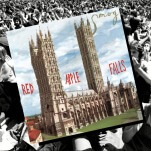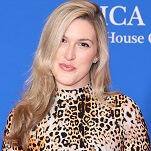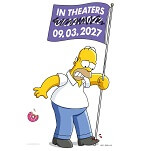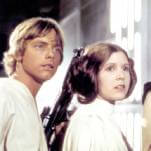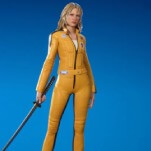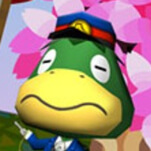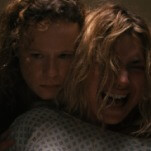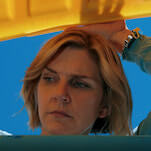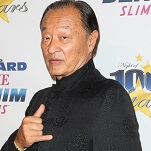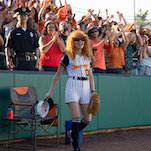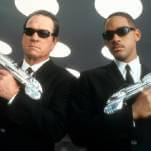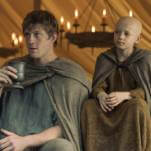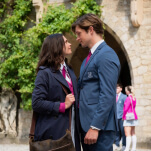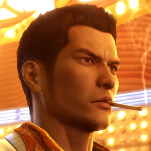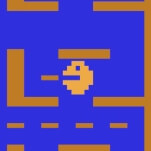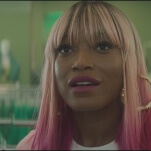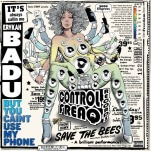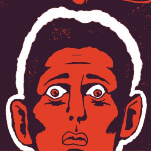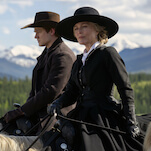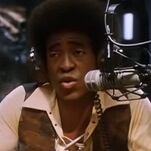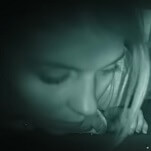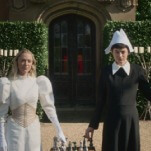“Am I shitting? It feels like I’m shitting!” Thus begins Saga #1 (Image), Brian K. Vaughan’s triumphant return to comics after a year and a half away in Hollywood. An epic sci-fi fantasy ongoing with masterful artwork from Fiona Staples, Saga is Vaughan’s most ambitious project yet, one that deftly combines high drama and humor. The opening line, yelled by a mother mid-birth, disguises the story’s high stakes, easing readers into the new world with comedy as Vaughan spends the first scene building a believable relationship between Saga’s lead characters. Establishing that central relationship is the issue’s greatest success, and gives the story emotional depth before Vaughan and Staples dive into the series’ high concept.
Two lovers from opposite warring factions in a generations-spanning war, Alana and Marko are new parents in a world of chaos, desperate to show their daughter a better world. It’s a fitting allegory for contemporary parenthood, heightening the fear, anxiety, and hope that a child represents for a couple. Few writers can match Vaughan when it comes to crafting a captivating and immersive first issue, and seeing him work without any sort of limitations reveals just how talented he is at giving his world instant definition.
Vaughan began creating the world of Saga as a child, and that youthful imagination is captured in Staples’ art. This is a world populated by winged policemen, monkey mechanics, and half-man/half-goat magicians. Giant cats can tell when someone is lying, crocodiles serve as butlers to high society-types with television-heads, and Marko and Alana look for the Rocketship Forest to get off their destitute planet. Want to see a giant turtle shoot down spaceships with its laser-beam eyes? It’s in Saga. Drawing and coloring the entire double-sized issue, Fiona Staples is about to become the next big thing in comics, with photo-realistic art put through a Pixar-like filter. It’s dynamic, innovative (explosions and temper tantrums knock the corners off panels), and a showcase of Staples’ extensive skills. Saga is a writer and artist at the top of their games, creating the emotional epic that Hollywood wishes it could make.
After writing the centuries-spanning Viking epic
Northlanders for five years, Brian Wood tackles one of the quintessential badasses from the North with
Conan The Barbarian #1 (Dark Horse). Teaming with frequent collaborator Becky Cloonan on art, Wood delves into the period of Conan’s past touched on in the classic Robert E. Howard story “Queen Of The Black Coast,” expanding on the Cimmerian’s partnership with Bêlit, the vicious, beautiful captain of the Tigress pirate ship. The first issue sets the stage beautifully, establishing the world with appropriately literary narration. Wood isn’t trying to modernize the character, instead doing his best Howard impression to showcase the
Conan creator’s timeless storytelling.
Cloonan has evolved past the heavy manga influence of her early work, and she continues to refine her art with Conan. Her interpretation of the hero is downright lean compare to the male figures in other comics, but the image fits the younger hero in Wood’s script. Conan is a cocky adventure-seeker in his 20s, and the establishing splash page of the character reveals him with a smile on his face as he flees a group of men on horseback. There’s still a hint of manga in Cloonan’s faces, but it lends itself to the script’s youthful exuberance, and the Japanese influence should make for some incredible action sequences as the story heats up.
The death of Bucky was a sacred cow of superhero comics until
Ed Brubaker took over
Captain America in 2005, doing the impossible and not only reviving Cap’s World War II sidekick, but turning him into one of Marvel’s most captivating characters. Thought dead to the rest of the world after the events of
Fear Itself, Bucky partners with Black Widow to atone for his past sins in his new ongoing series, tracking down Russian sleeper agents who haven’t lost the Cold War mentality. Part hard-boiled spy thriller, part fun-loving superhero adventure,
Winter Soldier #1 & #2 (Marvel) is the best Marvel debut since last year’s
Daredevil #1, with artist Butch Guice hitting a high point in an already distinguished career by partnering with colorist Bettie Breitweiser.
The level of detail on each page is astounding, as Guice fills pages with small, silent panels that flesh out the environment as the eye moves across the page. This is a book that rewards multiple readings, with the subtleties in Guice’s layouts gradually revealing themselves. Guice takes on a more graphic, Steranko-influenced style with this series, and Breitweiser’s bold color palette contrasts the scenes of heavy shadows with flashes of bright reds, greens, and blues to give the book the appearance of an old Technicolor spy film. Guice takes inspiration from Black Widow’s ballerina past when drawing her in action, showing an extraordinary handle on anatomy and creating fight scenes that have the visual splendor of a choreographed dance. In combining that artistry with a story that includes an attempted assassination on Dr. Doom and a machine-gun wielding gorilla with a jetpack, Brubaker, Guice, and Breitweiser have made Winter Soldier the first Marvel must-have of 2012.
With its off-kilter humor and distinctive, occasionally grotesque design sense, Pendleton Ward’s
Adventure Time has become a breakout hit for Cartoon Network, innocent enough for kids but with an aggressive weirdness perfect for the Adult Swim crowd. Boom Studios has a strong track record when it comes to adaptations, but none have captured the tone and visual style of the source material as completely as
Adventure Time #1 (Boom). Beginning with a nine-panel recreation of the cartoon’s opening sequence shown from a different angle, writer Ryan North and artists Shellie Paroline and Braden Lamb cleverly use the comic-book form to differentiate their book from the TV series by making each page a gag. By ending each page with a punchline, the creators maintain a comedic momentum that builds to the issue’s cliffhanger.
Paroline and Lamb replicate Pendleton’s style exactly, and because there’s no animation, the eye has time to take in the meticulous detail of each panel. Pendleton’s simple but expressive character designs allow for different artistic interpretations, and just as an episode of the cartoon changes art styles between segments, the comic book switches to a new creator’s vision for the back-up story. Spiral-Bound and The Unsinkable Walker Bean creator Aaron Renier handles the disturbing back-up about the Bubblegum Kingdom’s obsession with a new cider made from the armpit sweat of an anthropomorphized cinnamon bun, using a heavier line that adds texture to the environment and characters. It’s odd, gross, and strangely adorable, just like the best episodes of Adventure Time.
Also…
Rob Liefeld’s Wonder Woman rip-off Glory is the next character to get an update as part of Image’s Extreme Comics relaunch, but whereas last month’s Prophet actively distanced itself from the past, Glory #23 (Image) is a direct continuation of the character’s previous stories. Through the dreams of main character Riley, writer Joe Keatinge incorporates the work of past Glory writers, turning the title character into a Promethea-like figure that manifests in the subconscious of human women. (Fitting, since Promethea creator Alan Moore had a brief stint on the title.) Keatinge has an intriguing story here, but the dialogue is burdened by flagrant misuse of bold words, creating an unnatural cadence to a script that would otherwise flow naturally. Ross Campbell’s artwork is the major selling point for this title, and his full-bodied, round-faced design for Glory emphasizes both her strength and her youth. Panel borders disappear when the characters remember Glory, lending those pages a dreamlike fluidity, and the contrast of gruesome imagery with Campbell’s soft line creates a visual dynamic that will hopefully be expanded on in future issues.
Stories about young men forced to take action in World War II are nothing new, but Kurtis Wiebe spins a clever war story by taking inspiration from an unlikely source: J.M. Barrie’s Peter Pan. Peter Panzerfaust #1 (Image) recasts Peter as an American youth searching for his lost love in the Neverland of Nazi-occupied France, joined by a group of orphans as his war-bound Lost Boys. The connection to Barrie’s story creates an instant familiarity, requiring minimal exposition from Wiebe, who puts a lot of trust in Tyler Jenkins’ art to define the characters. Jenkins’ coarse line brings an appropriate grit to the war-torn environment, and he’s clearly done extensive research on machinery, equipment, clothing, and architecture to make the world as real as possible. Jenkins’ lanky Peter has an air of whimsy about him even when brandishing a rifle, and the moment he takes flight is the highlight of the issue, a bare-bones image that captures the exhilaration of soaring through the empty air.
Dan Didio and Keith Giffen’s revival of O.M.A.C. was one of the critical darlings of the New 52, but the book’s low sales have resulted in its cancellation with April’s #8. Now Didio is joined by classic artist Jerry Ordway for DC Universe Presents #6 (DC), featuring the New 52 debut of the fan-favorite Challengers Of The Unknown as adventurers in the reality-TV age. During the filming of the series Challengers, a group of D-list celebrities crash in the Himalayan Mountains, mysteriously appearing in the magical city of Nanda Parbat where they are given a second chance at life. Jeff Lemire and Scott Snyder might be getting most of the attention, but the real surprise of the DC relaunch is Didio, whose stories capture the energy and charm of the best Silver Age comic books. Ordway has a traditional style with a strong understanding of superhero comic fundamentals, staging clean action sequences and creating lush fantasy environments, and he even gets to stretch his horror muscles during the issue’s disturbing nightmare sequence. Together, Didio and Ordway craft a retro throwback that doesn’t take itself too seriously while still being tense and suspenseful.

